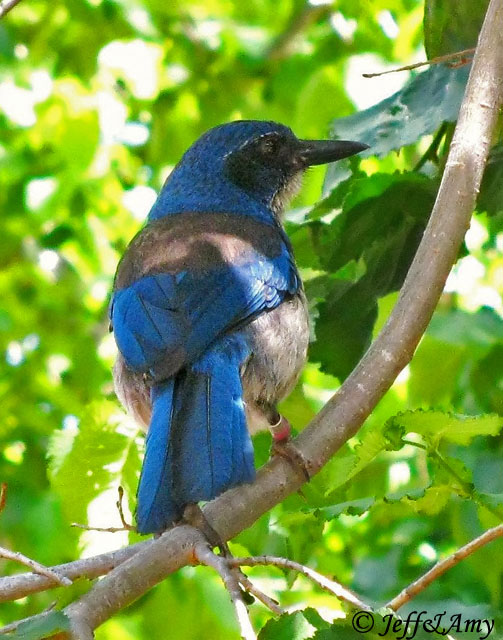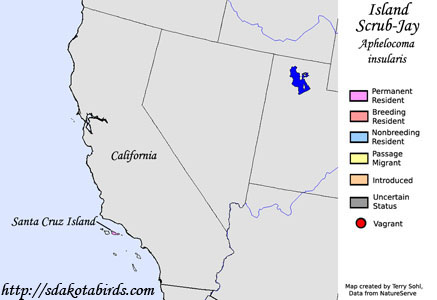Island Scrub-Jay
Aphelocoma insularis
| Length: 13 inches | Wingspan: 17 inches | Seasonality: Non-resident in South Dakota |
| ID Keys: Dark blue plumage on upperparts, brown patch on upper back, light underparts with blue undertail coverts, long thick bill compared to other Scrub Jays | ||
 The
Island Scrub-Jay likely has the smallest geographic range of any North
American bird species. The entire population is found on one small
island off the coast of California, Santa Cruz Island. There, recent
estimates put the total population at no more than 4,000 individuals, and
there may be as few as 1,000 breeding pairs in existence. While the
current population appears to be stable, given the very small breeding
range, they are susceptible to a single disturbance or disease event.
Given that West Nile Virus has taken a heavy toll on other Jay species in
parts of North America, there is some concern that the arrival of West Nile
Virus on Santa Cruz Island could have a strong negative impact on Island
Scrub-Jay populations. Note that the Island Scrub-Jay, the
Western Scrub-Jay, and the
Florida Scrub-Jay were until
relatively recently all considered one Scrub-Jay species.
The
Island Scrub-Jay likely has the smallest geographic range of any North
American bird species. The entire population is found on one small
island off the coast of California, Santa Cruz Island. There, recent
estimates put the total population at no more than 4,000 individuals, and
there may be as few as 1,000 breeding pairs in existence. While the
current population appears to be stable, given the very small breeding
range, they are susceptible to a single disturbance or disease event.
Given that West Nile Virus has taken a heavy toll on other Jay species in
parts of North America, there is some concern that the arrival of West Nile
Virus on Santa Cruz Island could have a strong negative impact on Island
Scrub-Jay populations. Note that the Island Scrub-Jay, the
Western Scrub-Jay, and the
Florida Scrub-Jay were until
relatively recently all considered one Scrub-Jay species.
Habitat: Found in oak woodlands, or scrub oak mixed with chaparral, on their small island range on Santa Cruz Island.
Diet: Omnivorous, feeding heavily on insects and other small invertebrates, but also feeding on seeds, nuts, and acorns, and less often on small vertebrates and eggs of other birds.
Behavior: Foraging may occur on the ground or in the foliage and branches of trees and shrubs, depending upon the food item being pursued.
Nesting: The nest of an Island Scrub-Jay is constructed of sticks and twigs, lined with finer material such as grasses and rootlets. It is placed in a shrub or small tree, anywhere from ground-level to 40 feet up. The female lays between 2 and 5 eggs. The female alone incubates the eggs, with the male bringing her food during the incubation period. When the eggs hatch, both parents help tend to and feed the young. The young leave the nest after about 18 days.
Song: Has a series of harsh calls, usually given in multiple phrases. Also has some low-pitched clucking sounds.
Migration: Considered a permanent resident on Santa Cruz Island.
Interactive eBird Map: Click here to access an interactive eBird map of Island Scrub Jay sightings
Similar Species: Similar in appearance to the other Scrub-Jay species, the Western Scrub-Jay and the Florida Scrub-Jay. However, the Island Scrub Jay is the only Jay species found on Santa Cruz Island, so in range, it is unmistakable. They can be distinguished from the other Scrub-Jay species by their larger size, their larger and thicker bill, and the increased amount of black on the forehead and nasal tufts.
Conservation Status: Population are small, and the geographic range is extremely small. The IUCN lists the Island Scrub Jay as a "Vulnerable" species.
Further Information: 1) National Park Service - Channel Islands - Island Scrub-Jay
2) Audubon - Island Scrub-Jay
3) BirdLife International - Island Scrub-Jay
Photo Information: Photo taken by Jeff & Amy - July 9th, 2009 - Santa Cruz Island off the coast of California - Photo licensed under Creative Commons Attribution NonCommercial ShareAlike 2.0 Generic License.
| Click below for a higher-resolution map |
 |
| South Dakota Status: Non-resident in South Dakota |
Additional Island Scrub-Jay Photos (coming soon!!)
